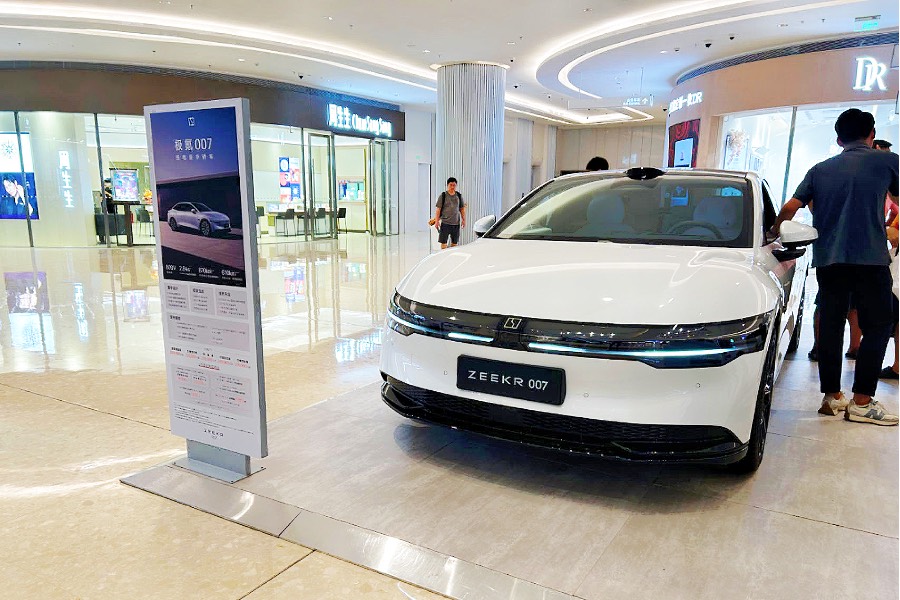After zipping on to Wall Street, Zeekr faces long road ahead

The electric vehicle maker that listed in New York last month said its losses continued to narrow in the first quarter
Key Takeaways:
- Zeekr’s first-quarter revenue from auto sales rose 73% year-on-year, but was down 23% quarter-on-quarter
- The Geely-backed company delivered about 68,000 electric vehicles in the first five months of this year, only 30% of its full-year target.
By Lau Chi Hang
The global electric vehicle (EV) market has become a bloody battlefield, littered with companies that roared out of the gate over the last decade, only to crash and burn in the overheated sector. Reflecting that, Gartner predicted that 15% of EV makers established in the past decade would be acquired or go bankrupt by 2027.
Even that estimate may be conservative. A more recent arrival to the race, Zeekr Intelligent Technology Holding Ltd. (ZK.US) is likely be a survivor, thanks in no small part to its strong ties to Geely, one of China’s leading automakers. But for now, at least, the company looks unlikely to find the profits it will need to operate sustainably anytime soon.
In its maiden quarterly earnings since its IPO, released last week, Zeekr reported revenue of 14.74 billion yuan ($2.03 billion) for the three months to March, up 71% year-on-year. Its EV business accounted for the majority of the total, rising 73% to 8.17 billion yuan. The company also reported a net loss of 2.01 billion yuan for the period, narrowing 16% year-on-year.
Weak sequential performance
While the year-on-year gains looked solid, the first-quarter revenue was less stellar on a sequential basis, dropping 9.9%. Automobile sales fell by an even larger 22.8% sequentially, and its gross margin fell 2.4 percentage points from the fourth quarter to 11.8% in the three months to March.
Zeekr did manage to pare its net loss by 32.6% on a sequential basis, but a closer look shows the decline was mostly due to cost cutting. The company slashed its R&D spending by nearly 40% to 1.93 billion yuan from 3.16 billion yuan in the previous quarter, while its sales and general administrative expenses fell to 1.95 billion yuan from 2.21 billion yuan.
Such drastic cuts in R&D spending might be good for a more mature company. But for a startup like Zeekr, such spending is often crucial in its early stages, and thus such efforts may prove more troubling, rather than reassuring, to investors.
But the most worrisome element to the report is the sharp sequential slowdown in the company’s EV deliveries. Zeekr managed to deliver just 33,059 EVs in the first quarter, down 16.6% quarter-on-quarter, despite rising 117% year-on-year. At the time of its listing, Zeekr said it aimed to deliver 230,000 electric vehicles this year. But with 16,089 units delivered in April and 18,616 in May, the company has delivered just 67,764 EVs in the first five months of the year, equal to only 29% of its target.
Looming delivery shortfall?
“117% year-on-year growth marks a new quarterly high and brings us one step closer to our full-year target of delivering 230,000 units,” said Zeekr CEO Andy An, when discussing the quarterly results. But his comments fail to capture the relentless turbulence shanking up the EV vehicle industry, especially in China, where weak consumer sentiment is making Zeekr’s target look increasingly unattainable.
Investors seemed to sense that as well, sending Zeekr’s shares down as much as 10% the day the results were announced, before they recovered slightly to close down 6.5% at $22.12. While the price is still slightly higher than last month’s listing price of $21, it is down more than 30% from its high of $32.24 last month.
The investment community seems quite conservative on Zeekr’s prospects. Simply stemming the flow of red ink to break even would already represent a major accomplishment for the company in the current market, never mind generating meaningful profits.
Speaking in an interview at the time of the IPO last month, CEO An elaborated on four major points that he said would support Zeekr’s development. First, he said, the penetration rate for EVs in China has already exceeded 50%, marking an inflection point for the overall auto market. Second, Zeekr plans to launch a pure electric SUV to complement its MIX electric minivan.
Third, he said, China’s major sales channels are gravitating towards the nation’s smaller cities. While 85% of Zeekr’s 350 stores are currently in first- and second-tier cities, it is planning to tap this new demand by establishing 70 marketing points in third- and fourth-tier Chinese cities starting this year. Lastly, Zeekr has been opening new stores in Sweden and the Netherlands since last November, and has also signed agreements with dealers in the Middle East and Asia.
Bloody competition
Investors seem skeptical about An’s plan. While EVs are increasingly popular in China, a large field of players is already in a tight race to the bottom, including industry leader BYD (1211.HK; 002594.SZ), the smaller “big three” of Nio (NIO.US; 9866.HK), XPeng (XPEV.US; 9868.HK) and Li Auto (LI.US; 2015.HK), and lesser names like Leapmotor (9863.HK), Hozon and Wuling, as well as supercharged newcomer Xiaomi (1810.HK). Add overseas giant Tesla (TLSA.US) to the mix, and the entire market has become a deep red sea of blood, plagued by cut-throat competition and slowing overall market growth.
Then there’s the big question of whether Zeekr’s ambitious new pure electric SUV will find an audience in the steady stream of new models being constantly released by all the companies. Clearly it won’t be easy for Zeekr to break through all the noise and quickly win over consumers with its new products.
Questions also hang over Zeekr’s plan to drive into smaller cities. The company has targeted the mid to high end of the market, with its cars typically costing an average of 300,000 yuan, beyond the budgets of most consumers in third- and fourth-tier cities. As many consumers rein in their spending, even major players like Nio are adapting to reality by rolling out cheaper brands like its Onvo, starting at 200,000 yuan, and Firefly, starting at 100,000 yuan. Moreover, many EV makers have already rolled out their own low-cost models to target China’s smaller cities, making it hard to see how Zeekr will find its own slice of the pie.
Exports could provide one relief valve from China’s overheated market, but even that route is quickly closing as the U.S. and EU take action to prevent a flood of Chinese imports. Last month the U.S. quadrupled its tariffs on Chinese EVs, citing unfair government subsidies. The EU took similar action last week, announcing that Chinese EVs will be subject to new tariffs starting next month, including an additional 20% for Geely. Such moves will make Chinese EVs far less attractive to European buyers, dealing a heavy blow to made-in-China brands looking for a piece of the European market.
To subscribe to Bamboo Works free weekly newsletter, click here





